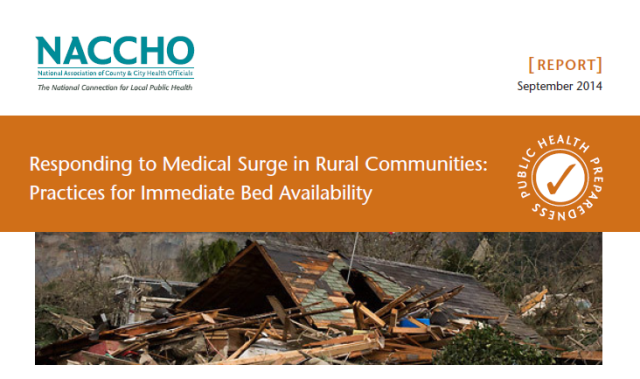Natural disasters, pandemics, and terrorist attacks have the potential to impact hundreds, thousands, or even tens of thousands of individuals within a community. During such events, those impacted can become ill or injured causing the healthcare system within the community to experience a “surge” of patients. To address the challenge of medical surge, local health departments and healthcare systems are using the practice of immediate bed availability (IBA). The Office of the Assistant Secretary for Preparedness and Response (ASPR) defines IBA as the ability of healthcare coalitions to provide no less than 20 percent bed availability, or staffed beds, within four hours of a disaster. To help achieve IBA, coalitions can participate in a number of different processes, such as off-loading non-critical patients, on-boarding the most serious patients, real-time continuous monitoring of patient needs and healthcare resources across all healthcare coalition partners, and tracking patient’s movement. While some of these practices are a normal part of healthcare operations, the application of IBA during medical surge, particularly in rural areas, is still a relatively new concept and less understood. In recognition of National Rural Health Day on November 20, 2014, NACCHO is highlighting a recent report that focuses on promising IBA strategies at rural local health departments.
 To address the unique needs of rural healthcare and better understand how it relates to IBA, ASPR asked NACCHO to identify promising practices that local health departments and healthcare coalitions are using to plan and execute IBA in rural communities. In a recent report, NACCHO interviewed state and local representatives in four jurisdictions – Mississippi, Southwest Utah, Virginia, and Southeast Texas – and identified four strategies that may enhance the ability of rural health departments and healthcare organizations to meet the needs of their community during an emergency resulting in medical surge:
To address the unique needs of rural healthcare and better understand how it relates to IBA, ASPR asked NACCHO to identify promising practices that local health departments and healthcare coalitions are using to plan and execute IBA in rural communities. In a recent report, NACCHO interviewed state and local representatives in four jurisdictions – Mississippi, Southwest Utah, Virginia, and Southeast Texas – and identified four strategies that may enhance the ability of rural health departments and healthcare organizations to meet the needs of their community during an emergency resulting in medical surge:
1. Establish and Leverage Partnerships
To help meet the needs of a community in the event of medical surge, many rural local health departments have established or leveraged informal or formal partnerships with both public health entities and community organizations. For example, the Southwest Utah Public Health Department, which covers five counties and approximately 17,000 square rural miles, not only built a healthcare coalition of traditional partners, but also developed non-traditional partnerships within the community. The coalition, which is hosted by the local health department and includes members such as hospitals, emergency management services (EMS), air transport, and long-term care facilities, participates in regular exercises by using the state-wide Utah Healthcare Resource Management System (UHRMS) to test their ability to update bed and resource capabilities. In addition, the local health department established relationships with local organizations to supplement hospital medical surge capacity. Schools, churches, and sporting venues within the community have been identified as temporary shelter, triage, and/or medical facilities for individuals with less severe injuries during a disaster.
2. Focus on Sustainable Practices
Rural jurisdictions cited reductions in healthcare preparedness funding, lack of additional space and equipment, and a shortage of healthcare workers as barriers for implementing IBA. To address these challenges, some rural health departments began focusing on the sustainability of healthcare coalitions, as well innovative information technology platforms. For example, local health departments and healthcare coalitions in rural areas are leveraging their state health department’s non-monetary resources to engage partner organizations in coalition activities, including exercises and planning for IBA. Other rural local health departments and healthcare organizations are looking to leverage information technology through the use of telemedicine. In Mississippi, to improve the availability of services to rural communities, the University of Mississippi Medical Center (UMMC) started a telehealth program and established telehealth sites across the state that can provide wellness care, psychiatric, emergency medical, and telemedicine services. During a medical surge situation, rural emergency departments have the opportunity to leverage the teleheath program by interacting remotely with other medical providers, which helps balance patient load and limit unnecessary transfers.
 3. Share Information and Integrate Data
3. Share Information and Integrate Data
To effectively implement IBA, healthcare personnel need accurate, timely, and detailed information about available beds and patients’ medical needs. This type of “real-time” information is possible through automated information sharing and integrated information technology systems. In Virginia, both the Department of Health and the Virginia Hospital and Healthcare Association (VHAA) realized that during a disaster, not only does the healthcare system have the ability to experience medical surge, but organizations assisting with family reunification may also experience a surge as separated families look for their loved ones. Recognizing that IBA can provide key informational inputs, the Virginia Department of Health and VHAA worked to integrate information from the Virginia Healthcare Alerting and Status System (VHASS), which tracks bed availability, with 2-1-1, which connects Virginia residents with community services. In the event of an emergency, patient information, as well as a triage tag and disaster number entered into VHASS. This information can then be accessed by 2-1-1 operators to help individuals reconnect with family members. In rural communities, this capability may be useful since patients have the ability to be evacuated or transported to healthcare facilities across the region for medical care.
4. Engage in Efforts to Define Crisis Standards of Care
The voices of local and rural healthcare and public health need to be heard in national, state, and regional conversations regarding crisis standards of care. Rural local health departments and healthcare partners can participate by coordinating with state leadership and by participating in regional workgroups or coalitions that develop guidance for crisis standards of care. The Utah Public Health Department recognized that lingering questions about crisis standards of care were one of the barriers to developing and implementing processes for medical surge and IBA. To address this challenge, the public health department began a five-year process to update and produce guidelines for crisis standards of care. As of September 2014, Utah has developed state-specific triage guidelines for hospitals, intensive care units, and EMS to guide the allocation of resources during an influenza pandemic.
Download the full NACCHO report to see what other challenges and promising practices states and local health departments are using for IBA (login required): Responding to Medical Surge in Rural Communities: Practices for Immediate Bed Availability
What promising practice or strategy is your local health department utilizing for IBA? Let us know if the comments section below.
NACCHO would also like to thank the following individuals for contributing their IBA practices and content for the final report:
- Steven Rossberg, Southwest Utah Public Health Department
- Jennifer Schitter, Virginia Department of Health
- Lori Upton, SouthEast Texas Regional Advisory Council
- Joyce Pearson, Mississippi Hospital Association Health, Research & Education Foundation
- Margaret Cooper, MS State Department of Health
- Wayne Vaughn, MS State Department of Health
- Terry McLeod, University of Mississippi Medical Center








